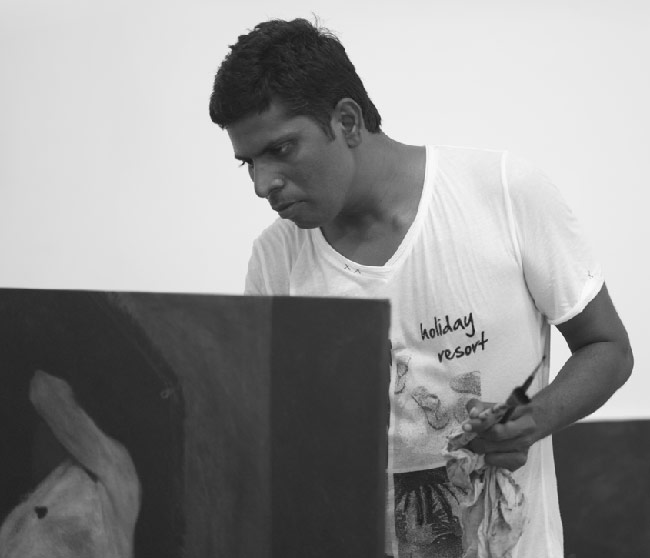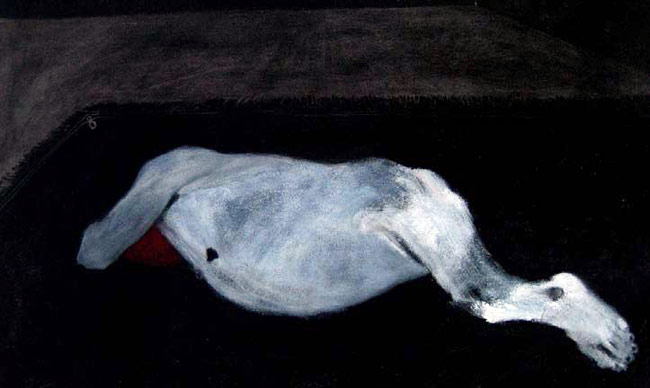N. Parsharamulu
This is a collection of articles archived for the excellence of their content. |
A profile
Gayatri Jayaraman
October 16, 2014
Parsharamulu, the son of a Telangana coal miner, lived 12 years in poverty to produce 10 canvases for his debut show
Parsharamulu at work at gallery MaskaraParsharamulu at work at gallery MaskaraWhen contemporary art gallerist Abhay Maskaralanded in Hyderabad inAugust, after months of communication with a young artist who had been sending him promising images of canvases, he suggested N. Parsharamulu come meet him at the airport. The idea was to have a chat with him on the way back to Karimnagar, where the artist lives in a rented tenement. But Parsharamulu, the son of a coal miner-who has done a Bachelor of Fine Arts from Jawaharlal Nehru Technological University, Hyderabad and a Master of Fine Arts from Chitrakala Parishath, Bangalore-declined. He had no money to make the trip. He had, in fact, just that morning, found Rs.200 lying on the road, and used it to buy a loaf of bread-his first meal in two days. Maskara travelled alone and the first thing he did when he reached Karimnagar was to share a meal with Parsharamulu. Then, in his one-room tenement with studies of primates and cave paintings taped to the disintegrating walls, he discovered his newest artist. And the next day Maskara sent him the dates for his debut solo. From October 14 to November 8, Parsharamulu's works will anoint the walls of Gallery Maskara in Mumbai's Colaba Causeway as a part of a show called 'Itself'. In the darkened gallery space, the artist, freshly exported out of his penance, has just finished putting the finishing touches to his 10 canvases, the only 10 he considers complete, from the last 12 years of an unceasing practice. "He told me, 'I've been painting for 10 years, but I consider everything done before a practice for these works, which are my only complete ones'. When he said that line, I knew I had found a true artist," Maskara says. Parsharamulu chokes back his tears as he tells of his days of struggle. He subsisted on donations made by friends from art school, and a Hyderabad collector, as and when they could. He would use half the amount to buy painting material and the rest he would use to pay his rent. His most humiliating encounters were not quite the penury itself but the act of having to sell works that were not ready yet. "Several times I approached galleries knowing my works were not ready but just because I needed the money..." he says, unable to complete the sentence that explains that no gallery would take a chance by accepting his works. So to have a Mumbai gallery finally come and view his works, and commit to dates for a debut solo, have proven overwhelming for an artist who has often subsisted on mere hope.
Untitled works of Parsharamulu which are a part of the Untitled works of Parsharamulu which are a part of the 'itself' seriesParsharamulu's work stands out in the context of a strong tradition of painting influences, both Indian and Western. He is being compared to British artist Francis Bacon, in psychological subtext, Norwegian painter Edvard Munch in primordialness, and Dutch artist Vincent Van Gogh in passion, intensity and stroke. And yet, he has seemingly managed to outgrow them all. In this growth, more than in the story of his antecedents, lies his promise.
Parsharamulu's canvases are aprimordial wracking of tortured forms squared onto dark-as-coal canvases. In strokes reminiscent of Indian painter Tyeb Mehta, slashes starkly cordon off spaces restricted by tradition, and borders recede and emerge, made fanciful in their functions of what is essentially a hemming in. "There is definitely a flash of Tyeb Mehta in him and it traces back to Francis Bacon who was also an abiding influence on Tyeb. Parsharamulu speaks in his own unique rough and simple style," says senior artist Sudhir Patwardhan."
His works are essentially studies of the human form, but as asexual, non ideal bodies. They come from studies of a history of art, from cave paintings to Italian artists Michelangelo and Leonardo Da Vinci's studies of the anatomy. "I asked myself, how does my work on the human body differ from say Gustave Courbet's? Mine do not aspire to be the ideal," Parsharamulu says. He adds, "I stopped before they acquire gender, because sexuality would put in meanings beyond what I mean them to be." There was a time when his personal angst was the dominant emotion of his canvases. "But that was a long time ago. I realised, over a period of time, angst is a part of the work, not it's whole," he says. He also spent the last 12 years moving out of the sphere of influence of masters he studied.
It is plain, given the buzz and excitement around him, that his circumstances will change. Says Ashiesh Shah, a Mumbai-based architect and art collector, "Though it is his debut solo, let's not forget it is not his first work, he has a body of nearly 300 paintings behind him. He is not an immature artist. Even though this exhibition is intensely specific and the 10 works are focused on one subject, he stands out with an intensity and freshness that is rare." Collector Akshay Jalan, who is toying with buying his work, adds, "I was moved by Parsharamulu's works; it has a deep spiritual impact on you; it moves you to different spaces-some dark and some happy.
Parsharamulu, meanwhile, finds himself flummoxed whenever he is asked, "What kept you going?" "Why? Art of course," he replies, as though there could not possibly have been any other answer.

